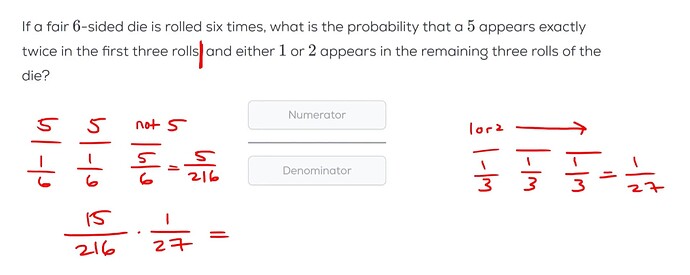I have also attached the solution, however have one question - why have we considered the # of cases of 5 in the first scenario and multiplied by 3, but in the second case of either rolling 1 or 2, we have not considered any scenario?
Can someone please explain the fundamental concept behind what I’m missing?
Wait is the solution correct?
The left side is correct: \binom{3}{2}(\frac{1}{6})^2(\frac{5}{6})^1 = \frac{5}{72} which is the reduced form of \frac{15}{216}.
But isn’t the right side: 1 - (\frac{4}{6})^3 = \frac{19}{27}?
The probability that something happens at least once is 1 minus the probability that it never happens. The probability that none of the remaining three rolls is 1 or 2 is (\frac{4}{6})^3 = \frac{8}{27}.
EDIT: Oh I think it means 1 or 2 appears in each of the remaining 3 rolls. Now I understand. The solution is correct.
@user2358 the reason for multiplying by 3 in the first scenario is that there are actually three distinct ways we can get two 5’s:
- 55R (5 the first roll and 5 the second roll and anything but 5 the third roll)
- 5R5
- R55
The probabilities for each of these cases is the same:
- 55R: \frac{1}{6} \cdot \frac{1}{6} \cdot \frac{5}{6} = \frac{5}{216}
- 5R5: \frac{1}{6} \cdot \frac{5}{6} \cdot \frac{1}{6} = \frac{5}{216}
- R55: \frac{5}{6} \cdot \frac{1}{6} \cdot \frac{1}{6} = \frac{5}{216}
because we’re multiplying the same three numbers each time, just in different orders. So you could compute all this. Or if you recognize ahead of time that all cases end up with the same probability, you can just calculate one of them and multiply by 3.
However, for the second scenario, there is only one way you can get a 1 or a 2 each roll: a 1 or 2 the first roll and a 1 or 2 the second roll and a 1 or 2 the third roll. This has probability: \frac{1}{3} \cdot \frac{1}{3} \cdot \frac{1}{3} = \frac{1}{27}.
If I were to guess, the “fundamental concept” you’re missing is that there are three ways to get two 5’s in the first scenario. Does this help?

